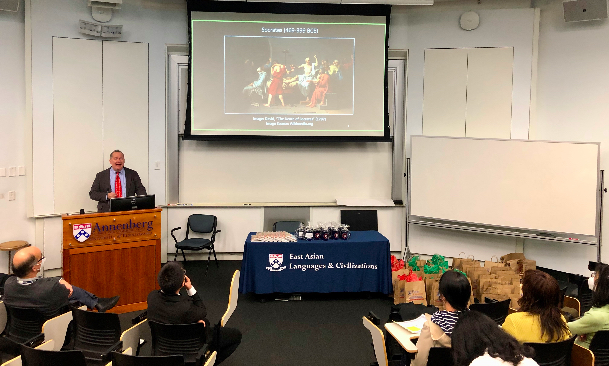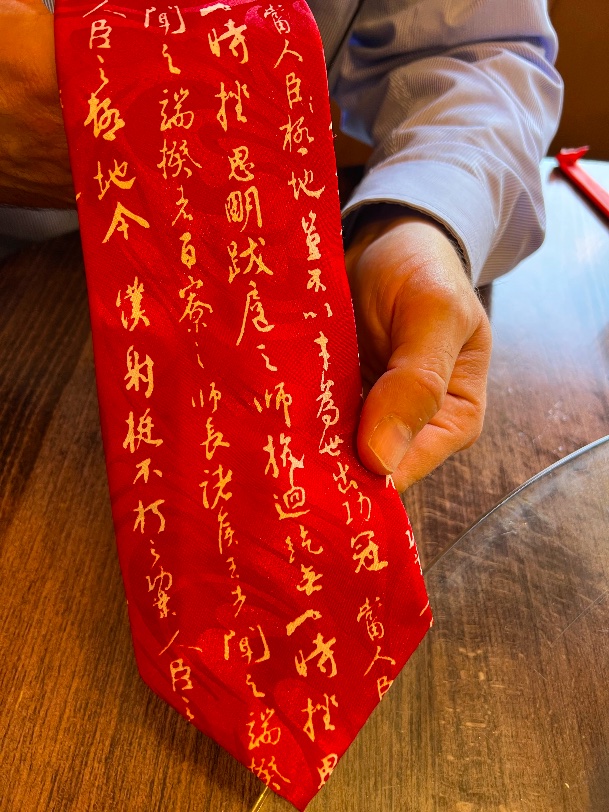Calligraphic tie: "Letter on the Controversy over Seating Protocol"
« previous post | next post »
On April 29, 2022, Bryan Van Norden (Vassar) gave students from the Penn Chinese Language Program a talk on the subject “What is happiness? Chinese and Western Conceptions,” in which he discussed several leading Chinese and Western views of what sort of life we should aim at. During the talk, Bryan was sporting a striking red tie (the slide on the screen shows Socrates taking the cup of hemlock, with which the lecture began):
Here's a closeup of the tie:
Upon examination, the inscription on the tie turns out to be a very curious piece written in 764 AD by the famous Tang calligrapher Yán Zhēnqīng 颜真卿 (709-785) titled "Zhēng zuòwèi tiè 争座位帖" (common translation "On Seating Arrangement"; following Amy McNair, normative translation “Letter on the Controversy over Seating Protocol”; my initial translation was something like "'Fighting over Seating': Calligraphy Model", but out of respect for Amy McNair, who is the art history expert on this piece, I left that out, and bring it up now only because a few people asked for something more literal). Since it is in cursive, the inscription is not easy for most people to read. Several sources say that it consists of 1,193 characters.
Diana Shuheng Zhang summarizes the contents and provides the contextual background:
This is actually Yan Zhenqing 颜真卿 (the author) scolding the second vice-minister (official title: you puye 右仆射), Guo Yingyi 郭英乂, to whom he was writing! Yan chastised Guo for behaving arrogantly and inappropriately in public several times, presuming on his political status in the court. The worst case was regarding the “seating arrangement”. During a Buddhist rite that was taking place at the Anfu Bodhisattva Temple 安福寺, in order to flatter a certain eunuch in power, named Yu Chao’en 鱼朝恩, Guo went so far as to place this eunuch’s seat in front of a high-ranking shàngshū 尚書 ("Minister"). This showed great disrespect to the Minister and blatant negligence of protocol. Guo’s behavior greatly infuriated Yan Zhenqing, causing him to write this long letter to warn Guo of how his arbitrary seating arrangement, which placed a favored eunuch in front of a high ranking government official, constituted serious damage to the standards and values of the court, and that if Guo would not realize what he had done and stop doing so in future, disaster would fall upon him.
The inscription is in the public domain and was published in facsimile by Shanghai Wenming Shuju 上海文明書局 in 1942. You may view it here. It is interesting to look at, since Yan seems to have dashed it off in white heat, inasmuch as there are interlinear notations and markings indicating rearrangements of the text, erasures, emphases, and so forth. Quite a remarkable document!
A Mandarin translation of the Literary Sinitic text may be found here.
Amy McNair has an English translation of the text in "Su Shih's Copy of the 'Letter on the Controversy over Seating Protocol'", Archives of Asian Art, 43 (1990), 40b-41a of 38-48.
This is not the first time I've written about a calligraphic item of dress on Language Log; see the initial entry under "Selected readings" below.
Selected readings
- "Christian Dior's 'Quiproquo' cocktail dress and the florid rhubarb prescription written on it" (6/5/15)
- "Robot calligraphy" (12/27/19)
- "Robotic copying" (2/22/19)
- "Mechanistic writing of Chinese characters" (9/14/19)
- "Writing characters and writing letters" (11/7/18)
- "The esthetics of handwriting" (5/8/16)
- "The esthetics of East Asian writing" (4/7/12)
- "Bad Chinese handwriting or just another style?" (10/3/17)
- "Handwriting legibility" (10/19/15)
- "Learning to write Chinese characters" (7/29/17)
- "Copying characters" (2/11/13)
- "Writing Chinese characters as a form of punishment" (11/1/15)
- "Cursive" (3/30/14)
- "Cursive and Characters: Dying Arts" (4/29/11)
- "The wrong way to write Chinese characters" (11/28/18)
- "Stroke order of Chinese characters" (9/4/18)
- "Idiosyncratic stroke order" (11/23/18) — and the long list of earlier posts at the bottom
- "Chaotic calligraphy" (8/6/18)
- "Character Amnesia" (7/22/10)
- "Chinese character inputting" (10/17/15)
- "The cost of illiteracy in China" (3/31/12)
- "The sociolinguistics of the Chinese script" (8/20/17)
- "The benefits of handwriting" (9/16/19)
- "'Collapsed' calligraphy" (12/3/19)
- "A new variant of a common Chinese character" (10/14/19)
[Thanks to Frederic Ye Tian and Jing Hu]


Philip Taylor said,
May 2, 2022 @ 1:24 pm
Unclear as to whether there is an intentional pun between "tie" and the final element of "Zhēng zuòwèi tiè".
Dan Romer said,
May 2, 2022 @ 3:18 pm
Is there a video recording of the talk? I'd love to see it.
J.W. Brewer said,
May 2, 2022 @ 3:48 pm
If you printed an English text onto a bolt of silk and then cut-and-sewed the result into a necktie, the words that were visible on the front of the tie would not necessarily be particularly coherent or meaningful unless you'd planned very carefully. Maybe vertical rather than horizontal writing helps, but you'd still need to make sure that important parts of context aren't folded around and on the back of the tie. Does the visible portion of the tie in the close-up make sense to someone who can read Literary Sinitic?
Philip Anderson said,
May 2, 2022 @ 5:19 pm
@Philip Taylor:
As a lover of puns, I would be disappointed if it were not deliberate.
Jonathan Smith said,
May 2, 2022 @ 9:25 pm
based on what is visible the designer seems to have tiled an excerpt of the inscription~rubbing, namely lines 5-8 of the original; the repeat begins about 4/5 of the way down the photo. Oddly, the lines are not in order though… so not much understanding shall be going on. Pasting from McNair's translation we would have (L-to-R):
7 stand as an example to the people. How but through your talent have you emerged above your generation? Your meritorious achievements crown
8 the age. You drove back Shih Ssu-ming's recalcitrant army and resisted the Uighurs’ in
5 heard that the grand councilor is the superintendent of all the officials, while the feudal lords and kings
6 are examples for their people. Now your eminent and imperishable meritorious achievements
Jonathan Smith said,
May 2, 2022 @ 9:26 pm
rather R-to-L of course
Jonathan Smith said,
May 2, 2022 @ 9:30 pm
oh — noting J.W. Brewer's thought, of course the lines are printed on the silk in order, it's just that what happens to appear on the front is not
Victor Mair said,
May 2, 2022 @ 9:51 pm
@ the two Philips, both of whom showed alert eyes to spot the apparent pun
Sorry to disappoint you, but it has absolutely nothing to do with punning — except completely accidentally.
I too noticed the fortuitous similarity between English "tie" and Mandarin tiè 帖, and would dearly have wanted to mention it in the post, but could find no justification for doing so except to say that it happened by pure chance, since the latter designation was applied to the calligraphed letter about a millennium before it was printed on Bryan's tie. Furthermore, except for the initial consonant, the two words don't sound remotely alike.
Victor Mair said,
May 2, 2022 @ 9:52 pm
As for what a tiè 帖 is, Wiktionary tells us that it is a "copybook; model; rubbing (for practicing calligraphy or painting)". I usually think of it as a model for calligraphy.
Philip Anderson said,
May 3, 2022 @ 1:09 am
@VM
I know the words are unrelated, and sound different, but I was entertaining the possibility that someone wanting a calligraphic tie might be tempted by a text with ‘tie’ in its title.
Victor Mair said,
May 3, 2022 @ 6:43 am
That's unlikely, Philip Anderson, since when the tie was sold — in Taiwan, I think Bryan told me — the packaging would most likely not have come with the Romanization for tiè 帖 on it.
Ben said,
May 3, 2022 @ 6:18 pm
I know very little about varieties of ancient Chinese compared to many who frequent these pages. (I started a Classical Chinese textbook once but didn't get more than a few lessons in…) It is commonly alleged that ancient texts represent a highly artificial register of the language. Do texts like this, clearly written without too much composition, evidence any systematic differences from standard compositions (as you would suspect if there is a huge gap between colloquial and literary registers)?
Victor Mair said,
May 3, 2022 @ 9:12 pm
@Ben
"It is commonly alleged that ancient texts represent a highly artificial register of the language."
The differences between Classical Chinese / Literary Sinitic and Vernacular Sinitic are so great that they amount to two separate language systems, with different grammar, syntax, and lexicon.
Ben said,
May 4, 2022 @ 12:15 am
@Victor Mair
And "Vernacular Sinitic" surely varied greatly by region and time.
My question is: is there evidence of the vernacular substrate in the Letter on the Controversy over Seating Protocol, Note on Abdominal Pain, or other rushed texts which are ostensibly written in Literary Sinitic?
Victor Mair said,
May 4, 2022 @ 1:00 am
@Ben
Yes, occasionally we do find traces of vernacular in such Literary Sinitic (LS) texts, but that happens only rarely, since LS authors are trained to assiduously weed out vernacularisms.
Ben said,
May 4, 2022 @ 2:56 am
@Victor Mair
Fascinating.
Interesting that LS authors are fluent enough in LS that they can prevent vernacularisms even in texts written under duress and with haste, such as this one. This level of fluency is not characteristic of many purely literary languages throughout history.
I was curious in the case of Controversy over Seating Protocol specifically since it was mentioned that the text contains repairs. I wondered if these repairs are the type that might be made by fluent language users under normal circumstances — rhetorical decisions, or a change of direction, for example — or if they indicate a slight disfluency which is improved through the repairs.
In either case, it seems this text has a lot to tell us about the sociolinguistic status of LS!
Victor Mair said,
May 4, 2022 @ 6:30 am
@Ben
Thank you for your thought-provoking, probing, productive questions and suggestions on two varieties of parallel, mostly not interconnected, language, one almost exclusively a written, book language (shūmiànyǔ 書面語), the other, throughout history, primarily a spoken language (kǒuyǔ 口語).
David Morris said,
May 4, 2022 @ 6:52 am
There should be Tai ties, including Thai ties, too.
David Morris said,
May 4, 2022 @ 6:53 am
Thai tie-dyed Tai ties, even.